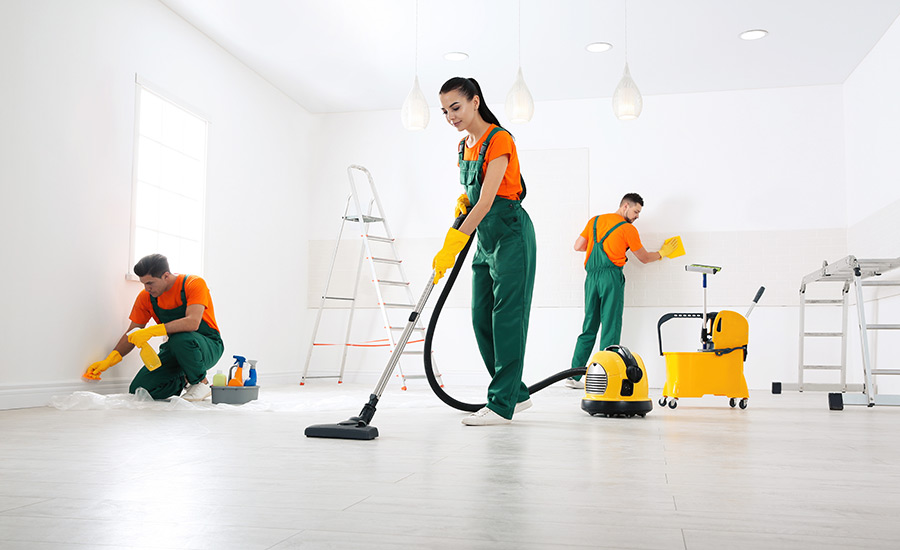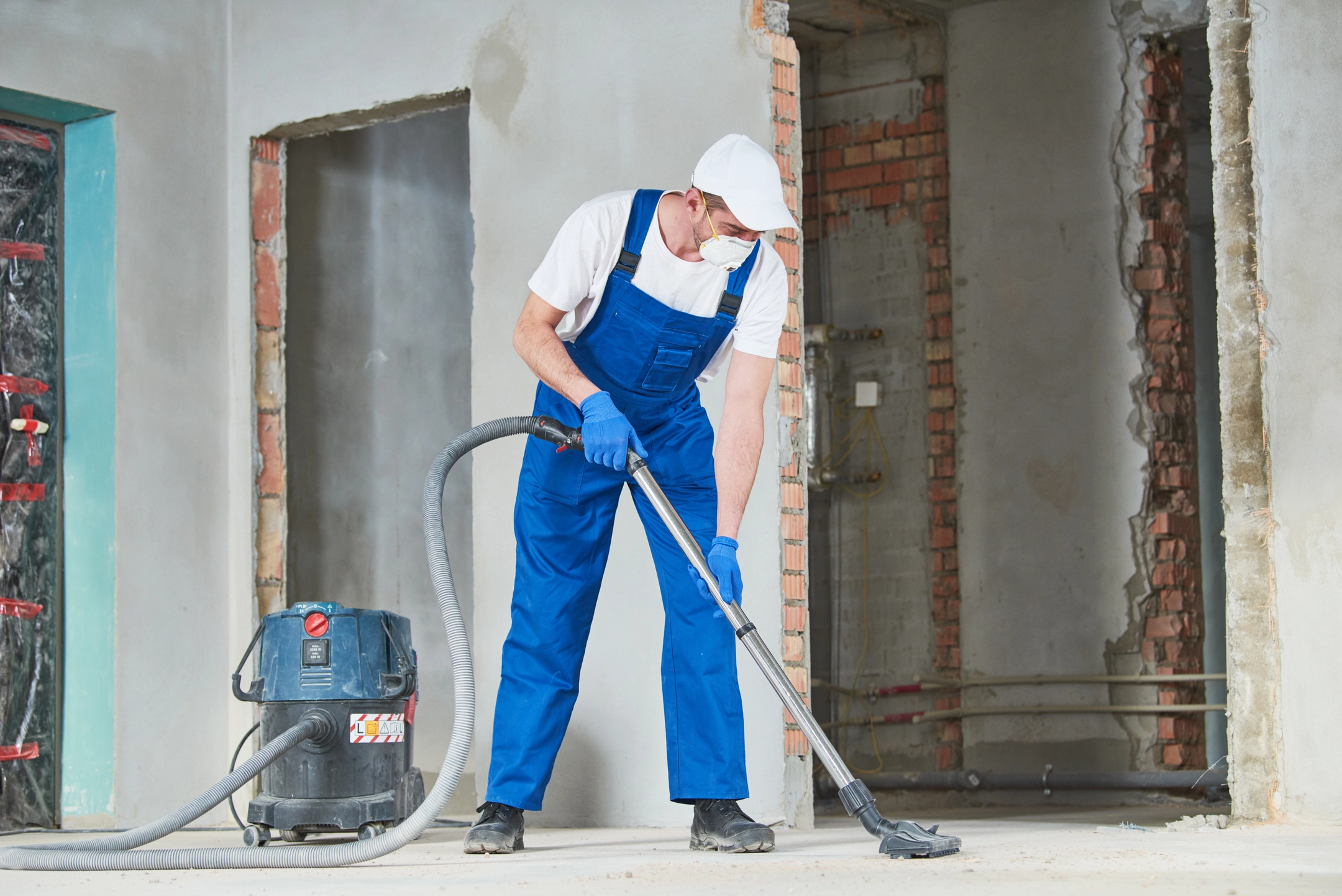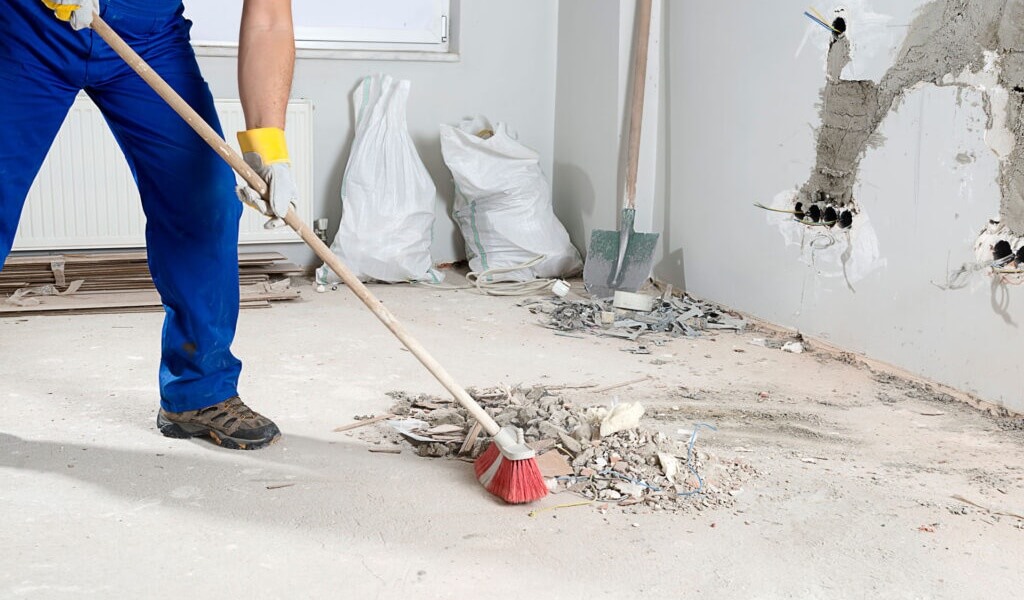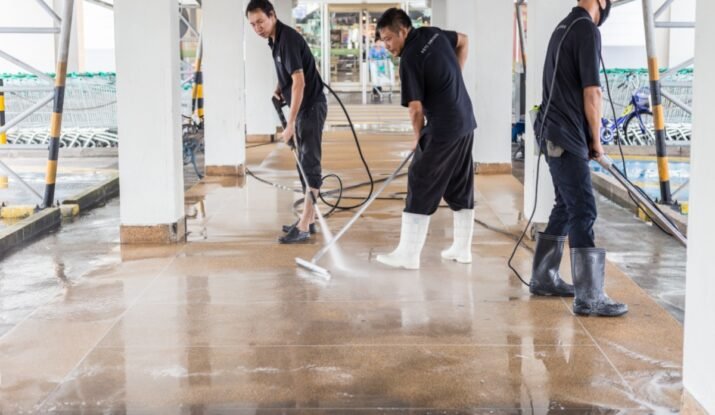Construction cleaning is crucial for any building project. It ensures the site is safe and ready for use.
After a construction project finishes, the site often looks chaotic. Dust, debris, and leftover materials can make the area unsafe and unpleasant. Construction cleaning transforms this mess into a clean, functional space. It involves removing waste, scrubbing surfaces, and ensuring everything is spotless.
This process not only makes the area look good but also ensures it is safe for occupancy. Whether it’s a new home, office, or commercial building, thorough cleaning is essential. It prepares the space for its final use, making it welcoming and ready for the next steps. So, let’s dive into why construction cleaning is so important and what it entails.
Types Of Construction Cleaning
Construction cleaning is essential for transforming a chaotic site into a pristine space. This process involves various stages to ensure every nook and cranny is spotless. Let’s explore the types of construction cleaning needed for a successful project.
Rough Cleaning
Rough cleaning occurs during the initial phase of post-construction cleanup. This stage focuses on removing larger debris and trash. Workers may use heavy-duty equipment for effective debris removal.
Key tasks include:
- Construction Waste Disposal
- Site Cleanup
- Debris Removal
During rough cleaning, workers tackle:
| Task | Description |
|---|---|
| Debris Removal | Clearing away large chunks of wood, metal, and other waste. |
| Site Cleanup | Sweeping and organizing the construction site. |
| Dust Removal | Using vacuums and brooms to control dust. |
This stage ensures the site is ready for the next steps of renovation cleaning. Rough cleaning is crucial for maintaining construction site sanitation and safety.
Final Cleaning
Final cleaning involves thorough cleaning services. This phase is about making the site presentable. Cleaning experts focus on every detail.
Tasks include:
- Deep Cleaning Services
- Building Cleanup
- Dust Removal
Important areas covered:
| Area | Details |
|---|---|
| Floors | Vacuuming and mopping all floor surfaces. |
| Windows | Cleaning and polishing glass surfaces. |
| Kitchens | Sanitizing countertops and appliances. |
Final cleaning ensures the space is ready for occupancy. It eliminates any remaining dust and dirt. This phase transforms the site into a clean, safe, and welcoming environment.

Importance Of Construction Cleaning
Construction cleaning is an essential part of the building process that often goes overlooked. It involves the removal of debris, dust, and leftover materials from a construction site. The importance of construction cleaning lies in both ensuring safety and enhancing the aesthetic appeal of the finished project. Proper cleaning not only meets safety regulations but also prepares surfaces for final inspection and boosts the overall appearance of the site.
Safety Concerns
Construction sites can be hazardous if not properly cleaned. Debris removal is crucial to prevent accidents and injuries. Sharp objects, leftover materials, and dust can cause slips, falls, and respiratory issues. Site sanitation ensures that hazardous materials are safely disposed of, minimizing environmental hazards. Effective dust control keeps the air clean, protecting workers from lung-related diseases.
Consider the following safety benefits of thorough construction cleaning:
- Reduced risk of accidents: Clean sites are less likely to have hidden dangers.
- Compliance with safety regulations: Adhering to safety standards prevents legal issues.
- Enhanced worker health: Proper cleaning reduces exposure to harmful substances.
Post-construction cleanup is integral to construction site maintenance. It involves a detailed cleaning process that ensures every corner of the site is free from potential hazards. A clean site is easier to inspect, making final inspection smoother and more efficient.
| Safety Aspect | Importance |
|---|---|
| Debris Removal | Prevents accidents and injuries |
| Dust Control | Protects respiratory health |
| Site Sanitation | Minimizes environmental hazards |
Aesthetic Appeal
The aesthetic appeal of a construction project is significantly enhanced by thorough cleaning. Surface preparation is vital for showcasing the beauty of new materials and finishes. Post-construction cleanup removes all traces of construction activity, revealing a polished and professional look.
Benefits of a clean construction site:
- Improved visual appeal: Clean sites highlight architectural details.
- Positive first impressions: A tidy site impresses clients and visitors.
- Enhanced property value: A well-maintained site can increase market value.
Construction site maintenance through regular cleaning ensures that the project remains attractive throughout its lifecycle. Cleanliness reflects professionalism and attention to detail, making the final product more appealing to potential buyers or tenants.
In summary, thorough cleaning not only meets safety regulations but also enhances the visual appeal of the construction project. It prepares the site for final inspection, ensuring both safety and beauty.
Tools And Equipment Needed
Construction cleaning is an essential part of every building project. Ensuring a clean site not only enhances safety but also prepares the space for occupancy. To achieve effective site sanitation, having the right tools and equipment is crucial. Below, we will explore the essential items needed for construction site cleaning, focusing on cleaning supplies and safety gear.
Cleaning Supplies
Effective construction site cleaning demands a variety of specialized supplies. These supplies help in tasks such as construction dust removal, debris removal, and post-construction cleanup. Here are some of the key items:
- Brooms and Dustpans: Heavy-duty brooms and large dustpans are essential for sweeping up dust and small debris.
- Industrial Vacuums: These are crucial for construction dust removal. They are designed to handle large volumes of dust and debris.
- Mops and Buckets: For cleaning floors, mops with sturdy buckets are necessary. Choose mops suitable for heavy-duty cleaning.
- Trash Bags and Bins: Durable trash bags and large bins help in efficient debris removal. They are essential for keeping the site tidy.
- Cleaning Solutions: Industrial cleaning supplies such as degreasers, disinfectants, and multi-purpose cleaners are important for thorough cleaning.
- Scrub Brushes: Stiff-bristled brushes are needed for scrubbing surfaces to remove stubborn dirt and grime.
| Item | Purpose |
|---|---|
| Brooms and Dustpans | Sweeping dust and small debris |
| Industrial Vacuums | Removing large volumes of dust |
| Mops and Buckets | Cleaning floors |
| Trash Bags and Bins | Debris removal |
| Cleaning Solutions | Thorough cleaning and sanitizing |
| Scrub Brushes | Removing stubborn dirt |
These supplies play a critical role in achieving a clean and safe construction site. Selecting the right tools ensures that the cleaning process is efficient and effective.
Safety Gear
Safety is paramount in construction site cleaning. Adhering to OSHA safety standards is crucial to protect workers from potential hazards. The following safety gear is essential:
- Protective Clothing: Wearing durable clothing protects against cuts, abrasions, and exposure to hazardous substances.
- Safety Glasses: These protect the eyes from dust, debris, and chemical splashes.
- Gloves: Heavy-duty gloves are necessary for protecting hands during debris removal and hazardous waste disposal.
- Respirators: Respirators are crucial for construction dust removal. They help prevent inhalation of harmful particles.
- Hard Hats: Essential for protecting the head from falling objects and bumps.
- Ear Protection: Construction sites can be noisy. Ear protection helps prevent hearing damage.
- Steel-toed Boots: These provide foot protection from heavy objects and sharp debris.
Ensuring that all workers use the appropriate safety gear is critical. It helps in minimizing accidents and health risks on the site. Here is a quick reference table:
| Gear | Purpose |
|---|---|
| Protective Clothing | Protection from cuts and abrasions |
| Safety Glasses | Eye protection |
| Gloves | Hand protection |
| Respirators | Dust inhalation prevention |
| Hard Hats | Head protection |
| Ear Protection | Hearing protection |
| Steel-toed Boots | Foot protection |
By using the right safety gear, workers can perform their duties more effectively and with less risk. Safety gear is an indispensable part of professional cleaning services at construction sites.

Step-by-step Cleaning Process
Cleaning a construction site is a critical task. It ensures safety, enhances the appearance, and prepares the space for its intended use. A systematic, step-by-step cleaning process makes the job more manageable and thorough. This guide will walk you through each stage, from the initial assessment to the detailed room-by-room cleaning, ensuring every corner shines.
Initial Assessment
The first step in post-construction cleanup is the initial assessment. This phase involves evaluating the site to understand the scope of work. Here, you identify the areas that need the most attention and the specific cleaning techniques required.
Key tasks during the initial assessment include:
- Inspecting all rooms and identifying hazardous materials.
- Noting areas with heavy debris accumulation.
- Assessing the need for deep cleaning services in high-traffic areas.
- Determining the extent of dust and dirt removal needed.
- Identifying surfaces that require special cleaning techniques.
Creating a checklist can be beneficial. It helps track tasks and ensures no area is overlooked. Here’s an example of a simple checklist:
| Task | Status |
|---|---|
| Debris Removal | Pending |
| Surface Cleaning Techniques | Pending |
| Dust And Dirt Removal | Pending |
| Safety Compliance Cleaning | Pending |
During the assessment, also consider the type of cleaning needed. This could range from final cleaning to construction site sanitation. Understanding these needs early on ensures effective and efficient cleaning.
Room-by-room Cleaning
After the initial assessment, proceed to room-by-room cleaning. This approach ensures thoroughness and helps manage the workload.
Start with the largest room and work your way to the smallest. This method keeps the process organized. Here’s a typical sequence:
- Living Areas: Begin with debris removal. Follow with surface cleaning techniques to ensure floors, walls, and windows are spotless. Special attention should be given to dust and dirt removal, particularly on windowsills and baseboards.
- Kitchens: Renovation cleanup in kitchens often requires deep cleaning services. Focus on appliances, countertops, and cabinets. Ensure all surfaces are sanitized for safety compliance cleaning.
- Bathrooms: Bathrooms need meticulous cleaning. Scrub tiles, clean fixtures, and ensure mirrors are streak-free. Address any construction site sanitation needs.
- Bedrooms: Dust and dirt removal is crucial in bedrooms. Pay attention to light fixtures, shelves, and corners. Ensure all surfaces are clean and free of debris.
Using the right tools and materials is essential. Microfiber cloths, heavy-duty vacuums, and eco-friendly cleaning agents can make the job easier and more effective.
By tackling each room methodically, you ensure a comprehensive cleanup. This leaves the construction site pristine and ready for occupation.
Common Challenges Faced
Construction cleaning is a crucial step in making a building safe and ready for use. It involves removing debris, controlling dust, and ensuring the site is clean and sanitary. While it seems straightforward, there are common challenges faced in this process. These challenges can affect the efficiency and safety of the cleanup. Tackling these issues requires expertise and the right tools.
Debris Removal
Debris removal is one of the most challenging aspects of post-construction cleaning. After a construction project, the site is often cluttered with various types of debris. These can include:
- Scrap wood
- Metal pieces
- Broken bricks
- Discarded packaging materials
Removing these items is essential for safety and cleanliness. Heavy-duty cleaning equipment is often needed to handle large and heavy debris. Moreover, proper debris disposal is crucial to comply with environmental regulations. Different materials need to be sorted and recycled where possible. This process can be time-consuming and labor-intensive.
In many cases, a combination of manual labor and machinery is used. Workers need to wear protective gear to avoid injuries from sharp or hazardous materials. Here’s a brief table summarizing the common debris types and their disposal methods:
| Debris Type | Disposal Method |
|---|---|
| Wood | Recycling or incineration |
| Metal | Recycling |
| Bricks | Reuse or landfill |
| Packaging Materials | Recycling |
Efficient debris removal ensures the site is safe for further work and inspection. It also helps in preparing the site for the next phase of building cleanup or renovation cleaning.
Dust Control
Dust control is another major challenge in construction site sanitation. Dust suppression is vital to maintain air quality and prevent health hazards. Dust can settle on surfaces, making them dirty and unsafe. It can also affect the respiratory health of workers and future occupants. To manage dust effectively, several strategies are used:
- Using industrial-grade vacuums to remove fine dust particles.
- Applying water or dust suppressants to prevent dust from becoming airborne.
- Sealing off areas to contain dust within specific zones.
Final cleaning services often include thorough dusting and vacuuming of all surfaces. Special attention is given to areas where dust can accumulate, such as:
- Windowsills
- Light fixtures
- Ventilation systems
- High shelves
Using air purifiers can also help in maintaining air quality. These devices can capture airborne dust, reducing its spread. Regular monitoring is essential to ensure dust levels remain low throughout the construction process. Effective dust control contributes to a healthier environment and a cleaner, safer site.
Both debris removal and dust control are integral to efficient site cleanup. Addressing these challenges ensures the site is ready for occupancy and meets safety standards. By using the right techniques and equipment, construction cleaning can be completed effectively and efficiently.
Eco-friendly Cleaning Solutions
Construction cleaning is a crucial part of any building project. It ensures that the site is safe and ready for use. Eco-friendly cleaning solutions are becoming more popular in this field. These solutions reduce the environmental impact of cleaning. They also promote sustainable cleaning practices. Using green cleaning products and techniques can make a big difference. Let’s explore how biodegradable products and water conservation can help in construction site cleanup.
Biodegradable Products
Using biodegradable products is essential for eco-friendly cleaning. These products break down naturally without harming the environment. They are safe for both workers and the ecosystem.
Here are some benefits of biodegradable products:
- Reduced Environmental Impact: They minimize pollution and are less harmful to wildlife.
- Safety: They are non-toxic and safe for workers handling them.
- Efficiency: They are effective in cleaning without leaving harmful residues.
In post-construction cleaning, biodegradable products are used for:
- Dust Control: Keeping the air clean and safe to breathe.
- Debris Removal: Breaking down waste materials safely.
- Cleaning Equipment: Ensuring tools are free from harmful chemicals.
Here is a comparison table of biodegradable vs. non-biodegradable products:
| Biodegradable Products | Non-Biodegradable Products |
|---|---|
| Environmentally friendly | Harmful to the environment |
| Safe for workers | Can be toxic |
| Effective cleaning | May leave harmful residues |
Water Conservation
Water conservation is another key aspect of eco-friendly cleaning. It involves using water wisely to reduce wastage. This is crucial in construction site cleanup where large amounts of water are often used.
Here are some water conservation tips for construction cleaning:
- Use Water-Efficient Equipment: Choose cleaning equipment that uses less water.
- Recycle Water: Reuse water where possible, such as for dust control.
- Limit Water Usage: Only use the amount of water needed for each task.
Benefits of water conservation in post-construction cleaning:
- Cost Savings: Reduces water bills and overall cleaning costs.
- Environmental Impact: Conserves water resources and reduces wastewater.
- Sustainable Practices: Promotes long-term sustainability in construction cleaning.
Implementing water conservation practices can significantly improve the efficiency of cleaning processes. It also supports the broader goal of sustainable cleaning practices in the construction industry.
Hiring Professional Services
Construction sites are often messy and filled with debris. After the work is done, a deep clean is essential to make the space safe and presentable. Hiring professional services for construction cleaning ensures the job is done efficiently and thoroughly. Professionals bring expertise, equipment, and a systematic approach to handle the cleaning needs of any construction site.
Benefits Of Professionals
Hiring professional construction cleaning services offers numerous advantages. Firstly, they have the right equipment and know-how to handle tough jobs. Removing construction dust and debris can be challenging without proper tools and techniques. Professionals use industrial-grade vacuums, high-powered washers, and specialized cleaning agents to ensure thorough cleaning.
Moreover, professionals provide comprehensive services including construction dust removal, site maintenance, and post-construction cleaning. They ensure that all areas, including hard-to-reach spots, are cleaned effectively. This guarantees a safer and healthier environment for occupants.
Here are some key benefits:
- Efficiency: Professionals work quickly and efficiently, minimizing downtime.
- Expertise: They understand the unique challenges of construction site cleanup and have the skills to address them.
- Safety: Proper cleaning reduces the risk of accidents and health hazards from leftover debris.
- Comprehensive Services: From debris removal to deep cleaning for contractors, they cover all aspects.
Professional services also offer flexible scheduling to accommodate your project timeline. This ensures that your site is cleaned when you need it, without delays.
Cost Considerations
Cost is a crucial factor when hiring professional cleaning contractors. The price can vary based on several factors such as the size of the site, the level of cleaning required, and the specific services you need. Understanding these factors can help you make an informed decision.
Let’s break down some of the cost considerations:
- Size of the Site: Larger sites require more time and resources, increasing the cost.
- Type of Cleaning: Basic cleanup may cost less than specialized services like industrial cleaning or renovation cleaning.
- Frequency: Regular site maintenance can be more cost-effective than one-time deep cleanings.
- Location: Prices may vary based on the local market and availability of services.
Below is a sample table to give you an idea of potential costs:
| Service Type | Estimated Cost |
|---|---|
| Basic Building Cleanup Services | $300 – $500 |
| Debris Removal Services | $500 – $1,000 |
| Deep Cleaning for Contractors | $1,000 – $2,500 |
| Industrial Cleaning Services | $2,500 – $5,000 |
To get the best value, it’s wise to compare quotes from multiple cleaning contractors. Ensure they provide a detailed breakdown of costs and services included. This helps you understand what you are paying for and ensures there are no hidden fees.
Investing in professional construction site cleanup may seem costly upfront, but it can save money in the long run by preventing damage and ensuring a safe environment.

Post-cleaning Maintenance
Construction cleaning is essential after any building project. It ensures that the space is safe, clean, and ready for use. Post-cleaning maintenance is crucial to maintain the cleanliness and safety of the construction site. This involves regular inspections and preventative measures to keep the area in top condition.
Regular Inspections
Regular inspections are vital for maintaining a clean and safe construction site. Conducting thorough inspections helps identify any areas that need attention. This process involves checking for debris, dust, and any leftover construction materials.
During these inspections, focus on the following:
- Dust Control: Ensure there is no accumulation of dust in the area. Dust can cause health issues and damage equipment.
- Debris Removal: Look for any construction debris that might have been missed. This includes nails, screws, and other small items.
- Environmental Considerations: Check for any potential environmental hazards. Proper disposal of hazardous materials is essential.
Creating a checklist can help streamline the inspection process. Here is an example:
| Inspection Task | Frequency |
|---|---|
| Dust Control | Weekly |
| Debris Removal | Daily |
| Environmental Considerations | Monthly |
Regular inspections ensure that the site remains safe and clean, preventing any potential hazards from going unnoticed.
Preventative Measures
Implementing preventative measures helps maintain the cleanliness of the construction site. This proactive approach reduces the need for extensive cleaning later.
Consider the following preventative measures:
- Site Maintenance: Regularly clean and maintain the site to prevent the buildup of dirt and debris.
- Deep Cleaning Services: Schedule periodic deep cleaning services. These services address areas that regular cleaning might miss.
- Safety Regulations: Ensure that all safety regulations are followed. This includes proper disposal of construction debris and hazardous materials.
By taking these steps, you can maintain a clean and safe construction site:
- Keep pathways clear of debris to prevent accidents.
- Use proper dust control methods to protect workers’ health.
- Dispose of construction debris properly to avoid environmental hazards.
Preventative measures not only maintain cleanliness but also ensure the safety and health of everyone on the construction site. Consistently applying these measures helps keep the site in optimal condition.
Frequently Asked Questions
What Is Construction Cleaning?
Construction cleaning involves removing debris, dust, and waste from a construction site. It ensures the area is safe and presentable.
How Much Do People Charge For A Construction Clean?
Construction clean costs vary widely. Rates typically range from $0. 10 to $0. 50 per square foot. For a comprehensive clean, expect to pay between $200 and $600 for residential projects. Commercial projects may cost more. Rates depend on location, size, and the level of cleaning required.
Always get multiple quotes.
Is Construction Cleaning Profitable?
Yes, construction cleaning can be profitable. High demand exists for post-construction cleaning services. Success depends on efficient operations, competitive pricing, and quality service.
What Is The Job Description Of A Construction Cleaner?
A construction cleaner removes debris, dust, and hazardous materials from construction sites. They clean floors, windows, and surfaces, ensuring the site is safe and presentable. They may also handle waste disposal and basic maintenance tasks.
Conclusion
A clean construction site speaks volumes about professionalism. It ensures safety and efficiency. Workers can move freely without obstacles. Clients appreciate a tidy, organized space. Effective cleaning protects equipment from damage. It also prevents unnecessary delays. Prioritize construction cleaning for smoother operations.
Every detail counts. Invest in a reliable cleaning service. You’ll see the benefits immediately. A clean site promotes success.

